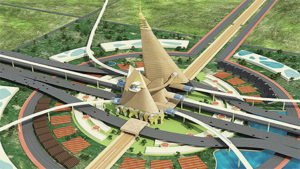 Delhi Mumbai Industrial Corridor Development Corporation is implementing the country’s most ambitious project – the Delhi Mumbai Industrial Corridor, building 24 cities along a 1,483-km fast railway track. Alkesh Sharma, CEO and Managing Director of DMIDC and Member Secretary & CEO of National Industrial Corridor Development & Implementation tells Mangala Chandran that the emphasis is on assured fluidity between all transport connections by ensuring coordination of different transport modes.
Delhi Mumbai Industrial Corridor Development Corporation is implementing the country’s most ambitious project – the Delhi Mumbai Industrial Corridor, building 24 cities along a 1,483-km fast railway track. Alkesh Sharma, CEO and Managing Director of DMIDC and Member Secretary & CEO of National Industrial Corridor Development & Implementation tells Mangala Chandran that the emphasis is on assured fluidity between all transport connections by ensuring coordination of different transport modes.
Is the first phase of DMICDC planned with six – seven cities on track?
The Delhi Mumbai Industrial Corridor project aims to create futuristic, smart and sustainable industrial cities by leveraging the high speed, high capacity connectivity backbone provided by the Western Dedicated Freight Corridor (WDFC), which will converge and integrate technology across sectors. The corridor that passes through six states spans a length of 1,504kms.
The Perspective Plan prepared for DMIC has identified 24 investment nodes after wide consultations with stakeholders including the State Governments and the concerned Central Government Ministries. The project influence area will be 150- 200kms on either side of the WDFC.
Out of the 24 investment nodes, eight nodes have been taken up for development as industrial cities in the first phase. These are Greenfield areas identified by the respective State Governments based on the availability of land, water and other parameters.
The nodes are listed below:
• Dadri-Noida-Ghaziabad Investment Region, Uttar Pradesh (210 sq. kms.)
• Manesar-Bawal Investment Region, Haryana (402 sq. kms.)
• Khushkhera-Bhiwadi-Neemrana Investment Region, Rajasthan (165 sqkms)
• Pithampur-Dhar-Mhow Investment Region, Madhya Pradesh (372 sqkms)
• Ahmedabad-Dholera Investment Region, Gujarat (920 sqkms)
• Dighi Port Industrial Area, Maharashtra (253 sq. kms.)
• Shendra-Bidkin Industrial Park, Aurangabad, Maharashtra (84 sqkms); and
• Jodhpur-Pali-Marwar Investment Region, Rajasthan (155sqkms)
The first phase is on track with trunk infrastructure facilities tied at plot levels being rapidly developed in four earlybird smart cities namely,
•  Dholera Special Investment Region (22.5 Sq. Kms.) in Gujarat;
Dholera Special Investment Region (22.5 Sq. Kms.) in Gujarat;
• Shendra Industrial Park (8.39 Sq. Kms.) at Aurangabad in Maharashtra;
• Integrated Industrial Township at Greater Noida (747.5 acres) in Uttar Pradesh; and
• Integrated Industrial Township at Vikram Udyogpuri (1100 acres) near Ujjain in Madhya Pradesh.
The land disposal policy has been finalised and plots are available for allotment to anchor tenants. For other project nodes also, development activities are being carried out as per the planned schedule.
High speed freight line, three ports, six airports and a six-lane intersection-free expressway connecting Delhi and Mumbai are being developed. How challenging is the implementation considering the number of connecting points and the involvement of six states?
The high-speed Western Dedicated Freight Corridor (WDFC) is being implemented by the Dedicated Freight Corridor Corporation of India (DFCCIL), a company under the Ministry of Railways entrusted to undertake planning & development, mobilisation of financial resources and construction, maintenance and operation of Dedicated Freight Corridors in India. The WDFC is the backbone of the DMIC project, as the project’s influence area is around both sides of the WDFC.
To drive Transit Oriented Development through manufacturing, MRTS are being developed. In addition, various Multi-modal Logistics Parks/ Hubs (MMLP-H) have been planned. The focus is on assured fluidity between all transport connections by ensuring coordination of all transport modes. This will enable the industrial corridors to build the distribution backbone of the country by connecting various demand points along the path of goods flow. This will improve the supply chain efficiency in India and spur growth and investments in the region.
Also, regional industry agglomeration could be achieved by attracting companies in the value chain of existing companies to the corridor, attracting particular industries where the corridor has geographical advantages or has advanced infrastructure for such industries.
 TrafficInfraTech Magazine Linking People Places & Progress
TrafficInfraTech Magazine Linking People Places & Progress